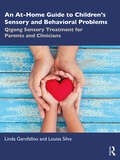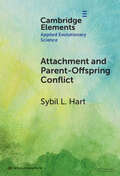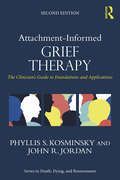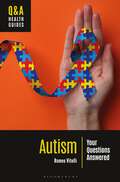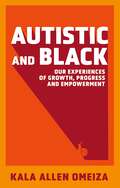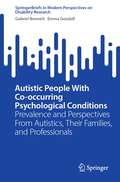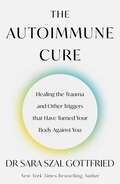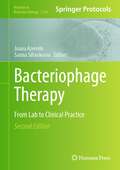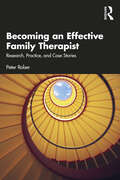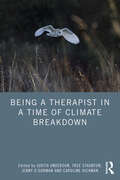- Table View
- List View
An At-Home Guide to Children’s Sensory and Behavioral Problems: Qigong Sensory Treatment for Parents and Clinicians
by Linda Garofallou Louisa SilvaAn At-Home Guide to Children’s Sensory and Behavioral Problems gives a new perspective on sensory and behavior problems, one that sees those behaviors as stemming from a child’s immature sensory nervous system and regulation difficulties. This book offers an effective at-home intervention, the Qigong Sensory Treatment, that enlists a parent's attuned touch to address often overlooked sensory issues that underlie ‘problem’ behaviors and works to organize those sensory experiences to foster connection and the capacity for self-regulation. It introduces the reader to a new and clinically useful model to understand sensory development, the Early Childhood Self-regulatory Milestones which are critical to the emotional and behavioral health and regulation for all children. With clear step-by-step instructions, diagrams, and links to online instructional videos, it teaches parents how to successfully implement the daily QST hands-on routine. Unique to the treatment model is how it guides and focuses parents to easily recognize, interpret and respond to their child's shifting non-verbal body and behavioral responses and cues. An extensive workbook section navigates parents through a year-long process of learning and implementing QST at home. Weekly letters include those written by the authors, parents who share their own personal experiences with the routine and by QST Master Trainers who offer their years of experience and helpful tips. The 52 letters are timed to anticipate and answer typical questions or stumbling blocks that parents commonly encounter at key points, guiding them to success with their child’s sensory and behavior difficulties while making for happier and less-stressful times with their child. This guide will be indispensable to parents and clinicians looking to understand and more effectively work with their child’s developmental difficulties.
An At-Home Guide to Children’s Sensory and Behavioral Problems: Qigong Sensory Treatment for Parents and Clinicians
by Linda Garofallou Louisa SilvaAn At-Home Guide to Children’s Sensory and Behavioral Problems gives a new perspective on sensory and behavior problems, one that sees those behaviors as stemming from a child’s immature sensory nervous system and regulation difficulties. This book offers an effective at-home intervention, the Qigong Sensory Treatment, that enlists a parent's attuned touch to address often overlooked sensory issues that underlie ‘problem’ behaviors and works to organize those sensory experiences to foster connection and the capacity for self-regulation. It introduces the reader to a new and clinically useful model to understand sensory development, the Early Childhood Self-regulatory Milestones which are critical to the emotional and behavioral health and regulation for all children. With clear step-by-step instructions, diagrams, and links to online instructional videos, it teaches parents how to successfully implement the daily QST hands-on routine. Unique to the treatment model is how it guides and focuses parents to easily recognize, interpret and respond to their child's shifting non-verbal body and behavioral responses and cues. An extensive workbook section navigates parents through a year-long process of learning and implementing QST at home. Weekly letters include those written by the authors, parents who share their own personal experiences with the routine and by QST Master Trainers who offer their years of experience and helpful tips. The 52 letters are timed to anticipate and answer typical questions or stumbling blocks that parents commonly encounter at key points, guiding them to success with their child’s sensory and behavior difficulties while making for happier and less-stressful times with their child. This guide will be indispensable to parents and clinicians looking to understand and more effectively work with their child’s developmental difficulties.
Attachment and Parent-Offspring Conflict: Origins in Ancestral Contexts of Breastfeeding and Multiple Caregiving (Elements in Applied Evolutionary Science)
by null Sybil L. HartThis Element builds on the mainstream theory of attachment and contemporary understanding of the environment of evolutionary adaptedness to address the origin and nature of infant-maternal bond formation. Sections 2 and 3 propose that attachment behaviors for protesting against separation and usurpation were compelled by infants' needs for close and undivided access to a source of breast milk, usually mothers, for three years to counter threats of undernutrition and disease that were the leading causes of infant mortality. Since these attachment behaviors would not have been presented unless they were compelled by maternal resistance, their arising is also attributed to parent-offspring conflict. Section 4 theorizes that the affectional nature of infant-maternal attachment originated within contexts of breastfeeding. Uniform and universal features of exclusive versus complementary breastfeeding, that could entail diverse experiences among multiple caregivers, may have shaped adaptations so that love relationships with mothers differ from those with nonmaternal caregivers.
Attachment-Informed Grief Therapy: The Clinician’s Guide to Foundations and Applications (Series in Death, Dying, and Bereavement)
by Phyllis S. Kosminsky John R. JordanAttachment-Informed Grief Therapy bridges the fields of attachment studies, thanatology, and interpersonal neuroscience, uniting theory, research, and practice to enrich our understanding of how we can help the bereaved. The new edition includes updated research and discussion of emotion regulation, relational trauma, epistemic trust, and much more. In these pages, clinicians and students will gain a new understanding of the etiology of problematic grief and its treatment, and will become better equipped to formulate accurate and specific case conceptualization and treatment plans. The authors also illustrate the ways in which the therapeutic relationship is crucially important – though largely unrecognized – element in grief therapy and offer guidelines for an attachment-informed view of the therapeutic relationship that can serve as the foundation of all grief therapy. Written by two highly experienced grief counselors, this volume is filled with instructive case vignettes and useful techniques that offer a universal and practical frame of reference for understanding grief therapy for clinicians of every theoretical persuasion.
Attachment-Informed Grief Therapy: The Clinician’s Guide to Foundations and Applications (Series in Death, Dying, and Bereavement)
by Phyllis S. Kosminsky John R. JordanAttachment-Informed Grief Therapy bridges the fields of attachment studies, thanatology, and interpersonal neuroscience, uniting theory, research, and practice to enrich our understanding of how we can help the bereaved. The new edition includes updated research and discussion of emotion regulation, relational trauma, epistemic trust, and much more. In these pages, clinicians and students will gain a new understanding of the etiology of problematic grief and its treatment, and will become better equipped to formulate accurate and specific case conceptualization and treatment plans. The authors also illustrate the ways in which the therapeutic relationship is crucially important – though largely unrecognized – element in grief therapy and offer guidelines for an attachment-informed view of the therapeutic relationship that can serve as the foundation of all grief therapy. Written by two highly experienced grief counselors, this volume is filled with instructive case vignettes and useful techniques that offer a universal and practical frame of reference for understanding grief therapy for clinicians of every theoretical persuasion.
The Authentic Organization: How to Create a Psychologically Safe Workplace
by Gina Battye"The Authentic Organization is an empowering guide, offering an approachable framework for organizations to go beyond diversity and inclusion. It is an invaluable resource for any leader hoping to gain and maintain a competitive edge in today's talent market!" - Sergio Rodriguez, Senior Manager, Global Workforce DEI Solutions "The Authentic Organization deals with a hugely important topic – how to create Psychological Safety in the workplace. This book is insightful, practical, fun and easy to read!" -Andreas Richter, Professor of Organisational Behaviour, University of Cambridge “This is a timely book, written with heart. There is an increasing focus on Psychological Safety and Gina brings the concept to life, explaining how to make it a reality for everyone in our organisations.” -Simon Blake, Chief Executive Officer, Mental Health First Aid England Mastering Psychological Safety: Your definitive guide to cultivating a psychologically safe workplace In The Authentic Organization: How to Create a Psychologically Safe Workplace, CEO of the Psychological Safety Institute Gina Battye, delivers a hands-on manual to create work environments where people thrive. You’ll discover actionable strategies to establish a psychologically safe workplace; challenging and transforming workplace attitudes and outdated workplace cultures. Expect to experience a paradigm shift where psychological safety is at the core, enabling an inclusive culture and catalyzing organizational success. This book goes beyond the mechanics of creating a safe workplace, it also empowers individuals to unleash their authentic selves, not just surviving, but truly thriving, both professionally and personally. You’ll gain valuable insights and practical guidance to bring your authentic self to work, effectively navigate workplace interactions and create a highly conducive environment for teamwork and collaboration. Ultimately, you will have everything you need to drive cultural change and take an active role in creating a psychologically safe environment that empowers your team and transforms your entire organization. Gina masterfully navigates you through her distinctive approach, the world-renowned 5 Pillars of Psychological Safety framework, meticulously designed to cultivate an environment where your organization and people thrive. Within these pages you will encounter: A transformative process that empowers individuals to bring their Authentic Self to work, tapping into hidden capabilities to excel in their professional lives. A comprehensive communication framework that equips individuals to effortlessly master effective workplace interactions. A ground-breaking methodology that cultivates an environment where teams thrive and collaborate effectively in a calm and focused workplace setting. A must-read blueprint for anyone aiming to create psychologically safe work environments, The Authentic Organization is your comprehensive guide to cultivating a workplace where individuals and teams thrive. This book is the ultimate manual that leaders, managers, human resources professionals, Employee Resource Group leads, and business innovators have been waiting years for.
The Authentic Organization: How to Create a Psychologically Safe Workplace
by Gina Battye"The Authentic Organization is an empowering guide, offering an approachable framework for organizations to go beyond diversity and inclusion. It is an invaluable resource for any leader hoping to gain and maintain a competitive edge in today's talent market!" - Sergio Rodriguez, Senior Manager, Global Workforce DEI Solutions "The Authentic Organization deals with a hugely important topic – how to create Psychological Safety in the workplace. This book is insightful, practical, fun and easy to read!" -Andreas Richter, Professor of Organisational Behaviour, University of Cambridge “This is a timely book, written with heart. There is an increasing focus on Psychological Safety and Gina brings the concept to life, explaining how to make it a reality for everyone in our organisations.” -Simon Blake, Chief Executive Officer, Mental Health First Aid England Mastering Psychological Safety: Your definitive guide to cultivating a psychologically safe workplace In The Authentic Organization: How to Create a Psychologically Safe Workplace, CEO of the Psychological Safety Institute Gina Battye, delivers a hands-on manual to create work environments where people thrive. You’ll discover actionable strategies to establish a psychologically safe workplace; challenging and transforming workplace attitudes and outdated workplace cultures. Expect to experience a paradigm shift where psychological safety is at the core, enabling an inclusive culture and catalyzing organizational success. This book goes beyond the mechanics of creating a safe workplace, it also empowers individuals to unleash their authentic selves, not just surviving, but truly thriving, both professionally and personally. You’ll gain valuable insights and practical guidance to bring your authentic self to work, effectively navigate workplace interactions and create a highly conducive environment for teamwork and collaboration. Ultimately, you will have everything you need to drive cultural change and take an active role in creating a psychologically safe environment that empowers your team and transforms your entire organization. Gina masterfully navigates you through her distinctive approach, the world-renowned 5 Pillars of Psychological Safety framework, meticulously designed to cultivate an environment where your organization and people thrive. Within these pages you will encounter: A transformative process that empowers individuals to bring their Authentic Self to work, tapping into hidden capabilities to excel in their professional lives. A comprehensive communication framework that equips individuals to effortlessly master effective workplace interactions. A ground-breaking methodology that cultivates an environment where teams thrive and collaborate effectively in a calm and focused workplace setting. A must-read blueprint for anyone aiming to create psychologically safe work environments, The Authentic Organization is your comprehensive guide to cultivating a workplace where individuals and teams thrive. This book is the ultimate manual that leaders, managers, human resources professionals, Employee Resource Group leads, and business innovators have been waiting years for.
Autism: Your Questions Answered (Q&A Health Guides)
by Romeo VitelliResearch suggests that about 1% of the world's population is on the autism spectrum. Discover the answers to common questions about living with neurodiversity.Part of the Q&A Health Guides series, this book offers a broad introduction to autism spectrum disorder (ASD). The book's 47 questions cover what ASD is and its common characteristics, the biological and environmental factors that may lead to ASD, how autism is diagnosed and managed, and how those living with ASD can reach their full potential. Autism: Your Questions Answered addresses these and other topics in a way that both celebrates neurodiversity and acknowledges the many challenges that those with ASD face.Augmenting the main text, a collection of 5 case studies illustrate key concepts and issues through relatable stories and insightful recommendations. The common misconceptions section at the beginning of the volume dispels 5 long-standing and harmful myths about ASD, directing readers to additional information in the text. The glossary defines terms that may be unfamiliar to readers, while the directory of resources curates a list of the most useful books, websites, and other materials. Finally, whether they're looking for more information about this subject or any other health-related topic, readers can turn to the guide to health literacy section for practical tools and strategies for finding, evaluating, and using credible sources of health information both on and off the Internet.
Autism Missed and Misdiagnosed: Identifying, Understanding and Supporting Diverse Autistic Identities
by Judy EatonAutism presents in a multitude of different and highly nuanced ways - particularly as it intersects with variance in class, gender, race and age. Misunderstanding and misinformation around variant and differing presentations means that misdiagnosed individuals and those who do not receive a diagnosis at all are often failed by medical, education, social care and criminal justice systems. They are detained in inappropriate settings; don't receive beneficial therapeutic input; have their families accused of fabricated or induced illness (FII); are kept in prison or youth offending institutions longer than their original tariffs, and shockingly their life expectancy is often curtailed as a result. This comprehensive resource will help multidisciplinary professions to understand, contextualise, and better identify diverse autistic presentations. It includes an overview of the autism diagnostic process, an exploration of controversial and commonly confused diagnoses such as PDA, ODD, CD, ASPD, and BPD; discussions of best practice for investigating FII; and analysis of the specific challenges of autism diagnosis in relation to women and girls, BAME communities, schools, and the criminal justice system.
Autistic and Black: Our Experiences of Growth, Progress and Empowerment
by Kala Allen Omeiza"It's time we bring forward Black autistic pain points and celebrate the triumphs of ourselves, family members, and organizations that care for these individuals. Through following the real stories of others from around the world, I hope fellow Black and autistic individuals will be empowered to realize that being Black and autistic is enough."In this powerful insight into the lives of Black autistic people, Kala Allen Omeiza brings together a community of voices from across the world, spanning religions, sexuality and social economic status to provide a deep and rich understanding of what it means to be autistic and Black.Exploring everything from self-love and appreciation, to the harsh realities of police brutality, anti-Black racism, and barriers to care, as well as amplifying the voices of the inspiring advocates who actively work towards change, protection, and acceptance for themselves and others, this book is an empowering force, reminding you that as a Black autistic person, you are enough.
Autistic People With Co-occurring Psychological Conditions: Prevalence and Perspectives From Autistics, Their Families, and Professionals (SpringerBriefs in Modern Perspectives on Disability Research)
by Gabriel Bennett Emma GoodallThis book provides a comprehensive overview of the experiences and challenges faced by autistics who also have co-occurring psychological conditions such as anxiety, depression, and gender dysphoria. The topic of autistics with co-occurring psychological conditions is currently of particular importance to the field of autism research because research has shown that a significant proportion of autistics also have co-occurring psychological conditions. However, these co-occurring conditions are often overlooked or misdiagnosed, which can lead to inappropriate or ineffective treatment. This book fills a critical gap in the literature by providing a comprehensive resource that addresses the specific needs of this population. This book aims to increase understanding and awareness of these co-occurring conditions among autistics, their families, caregivers, and mental health professionals.
The Autistic Survival Guide to Therapy
by Steph Jones"This is the book that would've saved me nine different therapists, decades of self-analysis, thousands of pounds, twelve different doctors and untold amounts of pain, frustration and trauma - in spending a lifetime looking for the right answers in the wrong places I've become an accidental expert."In this candid, witty and insightful exploration into therapy, Steph Jones uses her professional and lived experiences as a late diagnosed autistic woman and therapist, as well as consulting therapists from across the world and tapping into the autistic community, to create the ultimate autistic survival guide to therapy.Steph confronts the statistics, inadequate practices and ableist therapists head on and poses the questions of how we can make therapy neurodivergence-affirming and how to create safe spaces for autistic individuals. With strategic and practical advice to help recognise the 'red flags' of a dodgy therapist and provide a clear roadmap to finding your confidence and setting the appropriate boundaries with a new therapist, Steph has every question answered.To support therapists striving for inclusivity and a neurodiverse affirming practice, the inclusion of a context guide provides a deconstruction of each therapy session so you can recognise how undiagnosed (or diagnosed) autism may present itself during therapy and how you can start to explore this in the therapeutic space.
The Autoimmune Cure: Healing The Trauma And Other Triggers That Have Turned Your Body Against You
by Sara GottfriedNew York Times bestselling author Dr Sara Szal Gottfried reveals how trauma can rewire your body to trigger autoimmune diseases - and provides a comprehensive plan to reset your immune system and finally healWe know that autoimmune disease - a condition when the body's immune system attacks its own healthy tissue and cells - affects millions of people worldwide. But as New York Times bestselling author Dr Gottfried explains in this eye-opening new book, autoimmune disease may be even more pervasive than we realise - and its cause may surprise you.Conventional medicine falls short when it comes to both diagnosing and treating autoimmune disease. Many people suffer from mysterious symptoms like severe fatigue, brain fog, aches and pains, feelings of tingling and numbness, stubborn weight gain, abdominal pain, digestive problems, hair loss, insomnia, and even anxiety, and don't realize their immune system is at the root of their symptoms. In her precision medicine practice, Dr Gottfried noticed a seemingly unusual pattern: many of her patients who suffer from autoimmune disease and symptoms have a history of trauma. Emerging research shows that up to 80 per cent of patients with autoimmune disease experienced significant emotional distress before getting sick.With The Autoimmune Cure, there is hope on the horizon for the tens of millions of people who suffer from autoimmune disease. Dr Gottfried has created a powerful programme designed to break the vicious cycle of autoimmune disease, reset your immune system and restore your health, with advice on diet, sleep, supplements, breathwork, microbiome restoration, somatic therapy and much more.The Autoimmune Cure offers a road map to lasting relief from autoimmune disease by addressing the underlying cause of the condition and healing the body, mind and spirit.
Bacteriophage Therapy: From Lab to Clinical Practice (Methods in Molecular Biology #2734)
by Joana Azeredo Sanna SillankorvaThis highly anticipated second edition details cutting-edge experimental approaches for bacteriophage research. This comprehensive volume details new and updated experimental approaches for isolating, formulating, and engineering bacteriophage medicinal products. Authored by leading experts and written in the highly successful Methods in Molecular Biology series format, each chapter includes introductions to their respective topics, lists of the necessary materials and reagents, step-by-step reproducible laboratory protocols, and valuable tips for troubleshooting and avoiding known pitfalls. Whether you are a seasoned scientist or a newcomer, Bacteriophage Therapy: From Lab to Clinical Practice, Second Edition provides essential tools and knowledge to advance bacteriophage research and its translation into innovative medicinal products and clinical therapies.
The Balanced Brain: The Science of Mental Health
by Camilla NordHow we can use what we&’ve learned about the brain to improve our mental healthThere are many routes to mental well-being. In this groundbreaking book, neuroscientist Camilla Nord offers a fascinating tour of the scientific developments that are revolutionising the way we think about mental health, showing why and how events—and treatments—can affect people in such different ways.In The Balanced Brain, Nord explains how our brain constructs our sense of mental health—actively striving to maintain balance in response to our changing circumstances. While a mentally healthy brain deals well with life&’s turbulence, poor mental health results when the brain struggles with disruption. But just what is the brain trying to balance? Nord describes the foundations of mental health in the brain—from the neurobiology of pleasure, pain and desire to the role of mood-mediating chemicals like dopamine, serotonin and opioids. She then pivots to interventions, revealing how antidepressants, placebos and even recreational drugs work; how psychotherapy changes brain chemistry; and how the brain and body interact to make us feel physically (as well as mentally) healthy. Along the way, Nord explains how the seemingly small things we use to lift our moods—a piece of chocolate, a walk, a chat with a friend—work on the same pathways in our brains as the latest treatments for mental health disorders.Understanding the cause of poor mental health is one of the crucial questions of our time. But the answer is unique to each of us, and it requires finding what helps our brains rebalance and thrive.With so many factors at play, there are more possibilities for recovery and resilience than we might think.
The Balanced Brain: The Science of Mental Health
by Camilla NordHow we can use what we&’ve learned about the brain to improve our mental healthThere are many routes to mental well-being. In this groundbreaking book, neuroscientist Camilla Nord offers a fascinating tour of the scientific developments that are revolutionising the way we think about mental health, showing why and how events—and treatments—can affect people in such different ways.In The Balanced Brain, Nord explains how our brain constructs our sense of mental health—actively striving to maintain balance in response to our changing circumstances. While a mentally healthy brain deals well with life&’s turbulence, poor mental health results when the brain struggles with disruption. But just what is the brain trying to balance? Nord describes the foundations of mental health in the brain—from the neurobiology of pleasure, pain and desire to the role of mood-mediating chemicals like dopamine, serotonin and opioids. She then pivots to interventions, revealing how antidepressants, placebos and even recreational drugs work; how psychotherapy changes brain chemistry; and how the brain and body interact to make us feel physically (as well as mentally) healthy. Along the way, Nord explains how the seemingly small things we use to lift our moods—a piece of chocolate, a walk, a chat with a friend—work on the same pathways in our brains as the latest treatments for mental health disorders.Understanding the cause of poor mental health is one of the crucial questions of our time. But the answer is unique to each of us, and it requires finding what helps our brains rebalance and thrive.With so many factors at play, there are more possibilities for recovery and resilience than we might think.
Be a More Productive Scholar
by null Kenneth A. KiewraSome scholars are highly productive. They break new ground and do it again and again. Their names and ideas are ubiquitous in scientific journals and scholarly books. They scoff at 'publish or perish.' To them, it's 'publish and flourish.' But how are they so productive, publishing hundreds of powerful works over their careers? Most graduate students, junior faculty, and even senior faculty have no idea. The methods of the productive are rarely taught and remain a hidden-curriculum. Kenneth A. Kiewra interviewed dozens of productive scholars to uncover the hidden curriculum of scholarly success. Be a More Productive Scholar now reveals those productivity stories and methods by dispensing more than 100 pointers for enhancing professional development and boosting scholarly productivity. Graduate students to seasoned scholars can benefit from this career-guiding advice.
A Beam of Intense Darkness: Wilfred Bion's Legacy to Psychoanalysis (Routledge Mental Health Classic Editions)
by James S. GrotsteinWritten by pioneering analyst and creative thinker, James Grotstein, A Beam of Intense Darkness offers a thorough overview and illuminating insight into the often-complex work of W. R. Bion. This psychoanalytic classic sees Grotstein introduce over 30 key Bionian theories, comprehensively explaining them to the reader before offering his own insight and commentary. Grotstein first encountered Bion as his analysand and, later, as his friend. This book offers a level of insight only possible through such a close relationship, and offers a dialogue between Bion and Grotstein as they delve into the inner workings of the human psyche. Throughout, Grotstein offers his own original thoughts on topics such as projective transidentification, transcendent position and the truth drive. With a new introduction from Nicola Abel-Hirsch, this book is an essential read for anyone interested in Bion’s work and legacy.
A Beam of Intense Darkness: Wilfred Bion's Legacy to Psychoanalysis (Routledge Mental Health Classic Editions)
by James S. GrotsteinWritten by pioneering analyst and creative thinker, James Grotstein, A Beam of Intense Darkness offers a thorough overview and illuminating insight into the often-complex work of W. R. Bion. This psychoanalytic classic sees Grotstein introduce over 30 key Bionian theories, comprehensively explaining them to the reader before offering his own insight and commentary. Grotstein first encountered Bion as his analysand and, later, as his friend. This book offers a level of insight only possible through such a close relationship, and offers a dialogue between Bion and Grotstein as they delve into the inner workings of the human psyche. Throughout, Grotstein offers his own original thoughts on topics such as projective transidentification, transcendent position and the truth drive. With a new introduction from Nicola Abel-Hirsch, this book is an essential read for anyone interested in Bion’s work and legacy.
Becoming an Effective Family Therapist: Research, Practice, and Case Stories
by Peter RoberThis book explores the link between the effectiveness of the family therapist and the complexity of the therapeutic relationship.For family therapists the therapeutic alliance is complex because there are different family members and the therapist must have an empathic relationship with each of them. Furthermore, the therapist is focused on facilitating the development of trust between the family members. The book highlights the family therapist, not as an interventionist, but as someone who is focused on establishing a good relationship with different family members. Centering the person of the therapist, this book includes research, theory, as well as case studies exploring topics such as the therapist’s emotion regulation, the therapist’s inner dialogue, and dealing with client feedback. Rober offers an empathetic perspective and accessible framework for family therapists, encouraging readers to use their intuition and self-supervision to build better awareness and stronger connections in the session.This book is essential for beginning and seasoned family therapists, systemic therapists, and graduate students.
Becoming an Effective Family Therapist: Research, Practice, and Case Stories
by Peter RoberThis book explores the link between the effectiveness of the family therapist and the complexity of the therapeutic relationship.For family therapists the therapeutic alliance is complex because there are different family members and the therapist must have an empathic relationship with each of them. Furthermore, the therapist is focused on facilitating the development of trust between the family members. The book highlights the family therapist, not as an interventionist, but as someone who is focused on establishing a good relationship with different family members. Centering the person of the therapist, this book includes research, theory, as well as case studies exploring topics such as the therapist’s emotion regulation, the therapist’s inner dialogue, and dealing with client feedback. Rober offers an empathetic perspective and accessible framework for family therapists, encouraging readers to use their intuition and self-supervision to build better awareness and stronger connections in the session.This book is essential for beginning and seasoned family therapists, systemic therapists, and graduate students.
Behavior Modification: What It Is and How To Do It
by Garry Martin Joseph J. PearBehavior Modification is a comprehensive, practical presentation of the principles of behavior modification and guidelines for their application. It introduces forms of behavior modification ranging from helping children learn necessary life skills, to training pets, to solving personal behavior problems. It teaches practical “how-to” skills, including discerning long-term effects; designing, implementing, and evaluating behavioral programs; interpreting behavioral episodes; observing and recording behaviors; and recognizing instances of reinforcement, extinction, and punishment. The material is presented in an engaging, readable format that assumes no prior knowledge of behavior modification or psychology. Specific cases and examples clarify issues and make the principles real. Guidelines throughout provide a ready source to use as a reference in applying the principles. Questions for Learning, an average of 25 per chapter, are included to support students in checking their knowledge of the material when preparing for tests and exams. Application Exercises are also included in most chapters to assist students in the development of the practical skills they will need to complete behavior modification projects effectively. Behavior Modification is ideal for courses in Behavior Modification, Applied Behavior Analysis, Behavior Therapy, the Psychology of Learning, and related areas; and for students and practitioners of various helping professions—such as clinical psychology, counselling, education, medicine, nursing, occupational therapy, physiotherapy, psychiatric nursing, psychiatry, social work, speech therapy, and sport psychology—who are concerned directly with enhancing various forms of behavior development.
Behavior Modification: What It Is and How To Do It
by Garry Martin Joseph J. PearBehavior Modification is a comprehensive, practical presentation of the principles of behavior modification and guidelines for their application. It introduces forms of behavior modification ranging from helping children learn necessary life skills, to training pets, to solving personal behavior problems. It teaches practical “how-to” skills, including discerning long-term effects; designing, implementing, and evaluating behavioral programs; interpreting behavioral episodes; observing and recording behaviors; and recognizing instances of reinforcement, extinction, and punishment. The material is presented in an engaging, readable format that assumes no prior knowledge of behavior modification or psychology. Specific cases and examples clarify issues and make the principles real. Guidelines throughout provide a ready source to use as a reference in applying the principles. Questions for Learning, an average of 25 per chapter, are included to support students in checking their knowledge of the material when preparing for tests and exams. Application Exercises are also included in most chapters to assist students in the development of the practical skills they will need to complete behavior modification projects effectively. Behavior Modification is ideal for courses in Behavior Modification, Applied Behavior Analysis, Behavior Therapy, the Psychology of Learning, and related areas; and for students and practitioners of various helping professions—such as clinical psychology, counselling, education, medicine, nursing, occupational therapy, physiotherapy, psychiatric nursing, psychiatry, social work, speech therapy, and sport psychology—who are concerned directly with enhancing various forms of behavior development.
Being a Therapist in a Time of Climate Breakdown
by Judith Anderson Tree Staunton Jenny O’Gorman Caroline HickmanThis book introduces readers to the known psychological aspects of climate change as a pressing global concern and explores how they are relevant to current and future clinical practice.Arguing that it is vital for ecological concerns to enter the therapy room, this book calls for change from regulatory bodies, training institutes and individual practitioners. The book includes original thinking and research by practitioners from a range of perspectives, including psychodynamic, eco-systemic and integrative. It considers how our different modalities and ways of working need to be adapted to be applicable to the ecological crises. It includes Voices from people who are not practitioners about their experience including how they see the role of therapy. Chapters deal with topics from climate science, including the emotional and mental health impacts of climate breakdown, professional ethics and wider systemic understandings of current therapeutic approaches. Also discussed are the practice-based implications of becoming a climate-aware therapist, eco-psychosocial approaches and the inextricable links between the climate crises and racism, colonialism and social injustice. Being a Therapist in a Time of Climate Breakdown will enable therapists and mental health professionals across a range of modalities to engage with their own thoughts and feelings about climate breakdown and consider how it both changes and reinforces aspects of their therapeutic work.
Being a Therapist in a Time of Climate Breakdown
This book introduces readers to the known psychological aspects of climate change as a pressing global concern and explores how they are relevant to current and future clinical practice.Arguing that it is vital for ecological concerns to enter the therapy room, this book calls for change from regulatory bodies, training institutes and individual practitioners. The book includes original thinking and research by practitioners from a range of perspectives, including psychodynamic, eco-systemic and integrative. It considers how our different modalities and ways of working need to be adapted to be applicable to the ecological crises. It includes Voices from people who are not practitioners about their experience including how they see the role of therapy. Chapters deal with topics from climate science, including the emotional and mental health impacts of climate breakdown, professional ethics and wider systemic understandings of current therapeutic approaches. Also discussed are the practice-based implications of becoming a climate-aware therapist, eco-psychosocial approaches and the inextricable links between the climate crises and racism, colonialism and social injustice. Being a Therapist in a Time of Climate Breakdown will enable therapists and mental health professionals across a range of modalities to engage with their own thoughts and feelings about climate breakdown and consider how it both changes and reinforces aspects of their therapeutic work.
